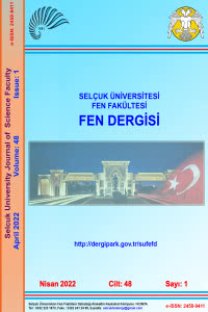SANTRİFÜJ BİR KALP DESTEK POMPASI PROTOTİPİNİN SAYISAL VE DENEYSEL OLARAK İNCELENMESİ
Numerical and Experimental Investigation of A Centrifugal Heart Assist Pump Prototype
___
- Arvand, A., Hahn, N., Hormes, M., Akdis, M., Martin, M., Reul, H., 2004 “Comparison of Hydraulic and Hemolytic Properties of Different Impeller Designs of an Implantable Rotary Blood Pump by Computational Fluid Dynamics”, Artificial Organs, Sayı:28(10), s. 892–898, Blackwell Publishing, Inc.
- Behbahani, M.,Behr, M., Hormes, M., Steınseıfer, U., Arora, D., Coronado, O., Pasqualı, M., 2009, “A Review of Computational Fluid Dynamics Analysis of Blood Pumps”, European Journal of Applied Mathematics, Sayı:20,s.363–397
- Demir, O.,Biyikli E., Lazoglu, I., Kucukaksu, S., 2011, “Design of a Centrifugal Blood Pump: Heart Turcica Centrifugal”, Artificial Organs, Sayı:35, No. 7, s.720-725
- Fan, H. M., Hong, F. W., Zhou, L. D., Chen, Y. S., Ye, L., Lıu, Z. M., 2009 “Design of Implantable AxialFlow Blood Pump and Numerical Studies on Its Performance”, Journal of Hydrodynamics, Sayı:21(4), s.445-452
- Fraser, K. H.,Zhang, T., Taskin, M. E., Griffith, B. P., Wu, Z. J., 2012, “A Quantitative Comparison of Mechanical Blood Damage Parameters in Rotary Ventricular Assist Devices: Shear Stress, Exposure Time and Hemolysis Index”, Journal of Biomechanical Engineering, Vol. 134 / 081002-1
- Reul H. M., Akdis M., 2000, “Blood Pumps for Circulatory Support”, Perfusion, Sayı: 15, s. 295–311 Lua P.C.,Laia H.C., Liub J.S., 2001, “A Reevaluation and Discussion on The Threshold Limit for Hemolysis in A Turbulent Shear Flow”, Journal of Biomechanics, Sayı:34, s. 1361–1364
- Masuzawa, T.,Tsukiya, T., Endo, S., Tatsumi, E., Taenaka, Y., Takano, H., Yamane, T., Nishida, M., Asztalos, B., Miyazoe, Y., Ito, K., Sawairi, T., Konishi Y., 1999, “Development of Design Methods For a Centrifugal Blood Pump with a Dynamic Approach: Results in Hemolysis Tests”, Artifical Organs, Sayı:23(8), s.757-761 Blackwell Science, Inc.
- Masuzawa, T.,Ohta, A., Tanaka, N., Qian, Y., Tsukiya, T., 2009, “Estimation of Changes in Dynamic Hydraulic Force in a Magnetically Suspended Centrifugal Blood Pump with Transient Computational Fluid Dynamics Analysis” The Japanese Society for Artificial Organs, Sayı: 12, s. 150–159
- Mizunuma, H., Nakajima, R., 2007, “Experimental Study on Shear Stress Distributions in a Centrifugal Blood Pump”, Artificial Organs, Sayı: 31(7), s. 550–559, Blackwell Publishing, Inc.
- Mozafari S., Rezaienia M. A., Paul G. M., Rothman M. T., Wen P., Korakianitis T. ,2017, “The Effect of Geometry on the Efficiency and Hemolysis of Centrifugal Implantable Blood Pumps”, ASAIO Journal, 63, 53–59
- Nishida, M., Maruyama, O., Kosaka, R., Yamane, T., Kogure, H., Kawamura, H., Yamamoto, Y., Kuwana, K., Sankai, Y., Tsutsui, T., 2009,”Hemocompatibility Evaluation With Experimental and Computational Fluid Dynamic Analyses for a Monopivot Circulatory Assist Pump”, Artificial Organs, Sayı: 33(4), s. 378–386, Wiley Periodicals, Inc.
- Ogami, Y., Matsuoka, D., Horie, M., 2010, “Computational Study of Magnetically Suspended Centrifugal Blood Pump (The First Report: Main Flow and Gap Flow)”, International Journal of Fluid Machinery and Systems, Sayı:3, No. 2. s.102-112.
- Stepanoff, A.J., 1957, Centrifugal and Axial Flow Pumps: Theory, Design and Application, 2 nd Ed. John Wiley&Sons Inc., New York, USA
- Song, G., Chua, L. P., Lım, T. M., 2010,“Numerical Study of a Centrifugal Blood Pump With Different Impeller Profiles”, ASAIO Journal, Sayı: 56, s.24–29.
- T.C. Sağlık Bakanlığı, Halk Sağlığı Kurumu, Türkiye Kalp ve Damar Hastalıkları Önleme ve Kontrol Programı, 988, Ankara, 2015
- Untaroıu, A., Wood, H. G., Allaıre, P. E., Throckmorton, A. L., Day, S., Patel, S. M., Ellman, P., Trıbble, C., Olsen, D. B., 2005, “Computational Design and Experimental Testing of a Novel Axial Flow LVAD”, ASAIO Journal, Sayı: 51, s.702–710.
- Yen, J. H.,Chen, S. F. , Chern M. K. , Lu P. C., 2014, “The Effect of Turbulent Viscous Shear Stress on Red Blood Cell Hemolysis“, The Japanese Society for Artificial Organs, Sayı: 17, s.178–185.
- Yu, S.C.M. , Ng, B.T.H., Chan, W.K., Chua, L.P., 2000, “The Flow Patterns within The Impeller Passages of a Centrifugal Blood Pump Model”, Medical Engineering & Physics, Sayı: 22, s.381–393
- ISSN: 2147-9364
- Yayın Aralığı: 2
- Başlangıç: 2013
- Yayıncı: Selçuk Üniversitesi Mühendislik Fakültesi
Osman DEMİRDÖĞEN, Hamit ERDAL, AHMET İLKER AKBABA
İNSANSIZ HAVA ARAÇLARI: TARİHÇESİ, TANIMI, DÜNYADA VE TÜRKİYE'DEKİ YASAL DURUMU
EXTENDED KALMAN FILTER DESIGN FOR RAILWAY TRACTION MOTOR
Güneş Enerjisi Destekli Hidrojen Üretimi: Teorik Bir Vaka Çalışması
ALİ ATEŞ, Sacit Zendehdel SHEKARDASHT, EYÜB CANLI
A MONOGENIC LOCAL GABOR BINARY PATTERN FOR FACIAL EXPRESSION RECOGNITION
Bir Çimento Fabrikası İnşaatı Sırasında Gözlemlenen Zemin Çökmeleri ve Sonuçları
SANTRİFÜJ BİR KALP DESTEK POMPASI PROTOTİPİNİN SAYISAL VE DENEYSEL OLARAK İNCELENMESİ
BİYOKÖMÜR: ÜRETİMİ ve KULLANIM ALANLARI
ERİMİŞ TUZ İÇİNDE ELEKTROKİMYASAL İNDİRGENME YÖNTEMİYLE SİLİSYUM ÜRETİMİ
Metehan ERDOĞAN, Emre ERGÜL, İshak KARAKAYA
KÜPRİK OKSİT/SİLİSYUM HETEROEKLEMLİ NANODİYOTLARIN FOTOVOLTAİK ÖZELLİKLERİ
